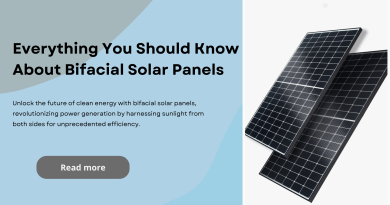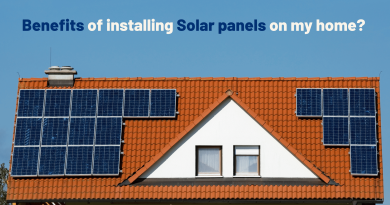Solar Panel Mounting Types & Benefits
Choosing the right solar panel mounting structure is a crucial step in any solar panel installation. The efficiency, longevity, and overall performance of your solar power system heavily depend on the type of mounting system used. Whether you’re planning a residential, commercial, or industrial project, understanding the various solar panel mounting types and their benefits ensures an informed decision.
Table of Contents
- 1 What is Solar Panel Mounting?
- 2 Types of Solar Panel Mounting Systems
- 3 Key Considerations Before Choosing a Mounting Type
- 4 Benefits of Choosing the Right Solar Panel Mounting
- 5 Why Mounting Matters in Solar Panel Installation
- 6 Cost Differences Between Mounting Systems
- 7 Long-Term Value: Mounting and ROI
- 8 Case Study: Rooftop vs Ground-Mount in Real Life
- 9 Environmental and Aesthetic Impact
- 10 How to Choose the Best System for Your Needs
- 11 Where to Buy the Best Solar Mounting Systems?
- 12 Conclusion
What is Solar Panel Mounting?
Solar panel mounting refers to the framework or structure used to fix solar panels securely in place. These mounting systems can be installed on rooftops, the ground, or other tailored structures. The main goal is to position the panels at an optimal angle and orientation to absorb the maximum sunlight, ensuring high performance of your solar power setup.
Types of Solar Panel Mounting Systems
1. Roof-Mounted Solar Panel Systems
Roof-mounted systems are the most common form of solar panel installation, especially for homes. They use the existing roof structure, minimizing the need for extra land or space.
Benefits:
- Cost-effective and easy to install
- Saves ground space
- Ideal for residential and urban installations
2. Ground-Mounted Solar Panel Systems
When roof space is limited or orientation is not ideal, ground-mounted solar panels become a practical solution. They are installed directly into the ground, allowing for customizable panel placement.
Benefits:
- Optimal angle and orientation
- Easier maintenance access
- Suitable for large-scale and rural setups
3. Pole-Mounted Solar Panel Systems
In this setup, solar panels are mounted on poles that can be fixed or equipped with tracking systems.
Benefits:
- Elevated for better sunlight exposure
- Can incorporate sun tracking for higher efficiency
- Minimal ground shading
4. Solar Tracking Systems
A high-efficiency option, these systems follow the sun’s movement throughout the day.
Benefits:
- Increases solar energy generation by 20–30%
- Ideal for locations with fluctuating sun exposure
- Maximizes return on investment
5. Building-Integrated Photovoltaics (BIPV)
These systems integrate solar panels directly into the structure of a building, such as windows or facades.
Benefits:
- Aesthetically pleasing
- Reduces the need for additional mounting hardware
- Doubles as construction material
Key Considerations Before Choosing a Mounting Type

1. Roof or Ground Space Availability
Assess how much space you can dedicate to your solar power system and its exposure to sunlight.
2. Budget Constraints
Different mounting systems vary in cost. Roof-mounted options are generally more affordable, while tracking systems are premium investments.
3. Sunlight Exposure and Angle
The geographical location and sunlight pattern affect the type of solar panel mounting you should choose.
4. Maintenance and Accessibility
Ground-mounted systems are easier to maintain compared to rooftop installations.
Benefits of Choosing the Right Solar Panel Mounting
Selecting the proper mounting system improves the overall performance and efficiency of your solar power setup. Here’s why it matters:
- Increased energy production
- Longer lifespan of solar panels
- Lower maintenance costs
- Better aesthetics and design integration
Why Mounting Matters in Solar Panel Installation
Incorrect mounting can lead to panel damage, water leakage, and even reduced energy output. Proper mounting ensures structural integrity, ventilation, and correct panel tilt.
Cost Differences Between Mounting Systems
| Mounting Type | Approximate Cost Range (INR per kW) |
|---|---|
| Roof-Mounted | 5,000 – 10,000 |
| Ground-Mounted | 10,000 – 15,000 |
| Tracking System | 20,000 – 35,000 |
Prices can vary based on material, installation complexity, and project scale.
Long-Term Value: Mounting and ROI
Investing in a proper solar panel mounting system contributes significantly to ROI by improving panel efficiency and reducing future maintenance costs.
Case Study: Rooftop vs Ground-Mount in Real Life
A commercial plant in Bengaluru installed roof-mounted solar panels, saving over 25% on energy bills. Conversely, a rural school used ground-mounted systems due to available space, optimizing sun exposure and cutting electricity costs by 40%.
Environmental and Aesthetic Impact
- Roof-mounted panels preserve ground area, beneficial in urban settings.
- Ground-mounted panels may require landscape alteration.
- BIPV systems blend in, perfect for green buildings.
How to Choose the Best System for Your Needs
- Evaluate sunlight exposure
- Determine space and budget
- Consult a professional solar panel installation service like SolarClue
- Check local regulations and load-bearing capacity
Where to Buy the Best Solar Mounting Systems?
For high-quality solar panel mounting structures and expert installation, visit SolarClue. They offer competitive pricing and trusted services for both rooftop and ground-mounted systems. Check also blog.solarclue.com for educational resources.
Conclusion
Understanding the different solar panel mounting types is key to optimizing your solar power system. With the right installation, you’ll ensure maximum energy generation, enhanced durability, and better ROI. Be it rooftop, ground, pole, or tracker-based systems, each type serves unique needs and environments. For expert guidance and reliable products, visit our trusted partner SolarClue.
Make your journey to solar energy smarter—explore the full guide on mounting options at blog.solarclue.com today!
FAQs
1. Which mounting type is best for home use?
Roof-mounted systems are best for residential homes due to cost-efficiency and ease of installation.
2. Can I switch from roof-mounted to ground-mounted later?
Yes, though it involves extra cost and reinstallation efforts.
3. Are solar tracking systems worth the cost?
Yes, if your goal is maximum efficiency and long-term ROI.
4. How long do solar mounting systems last?
They can last 25–30 years with proper maintenance.
5. Can I DIY install a mounting system?
It’s advisable to hire professionals to ensure safety, compliance, and performance.



